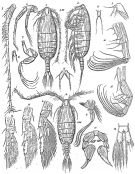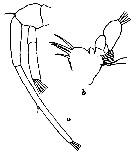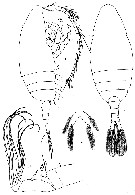|
|
 |
Fiche d'espèce de Copépode |
|
|
Calanoida ( Ordre ) |
|
|
|
Arietelloidea ( Superfamille ) |
|
|
|
Arietellidae ( Famille ) |
|
|
|
Paraugaptilus ( Genre ) |
|
|
| |
Paraugaptilus meridionalis Wolfenden, 1911 (F,M) | |
| | | | | | | Syn.: | Paraugaptilus buchani : Sars, 1925 (p.336); Rose, 1933 a (p.242: figs.F,M); Vives & Shmeleva, 2007 (p.166, figs.F,M); ? C.B. Wilson, 1950 (p.275, figs.F) | | | | Ref.: | | | Wolfenden, 1911 (p.353, figs.F); Sewell, 1948 (p.505); Deevey, 1973 (p.254, Rem.); Bradford, 1974 a (p.524, Rem.) |  Issued from : G.O. Sars in Résult. Camp. Scient. Prince Albert I, 69, pls.1-127 (1924). [Pl.CXXI, figs.1-18]. As Paraugaptilus buchani. Female (from W Canary Is. & Azores): 1, habitus (dorsal); 2, idem (lateral left side); 3, forehead (lateral); 4, rostrum; 5, A1; 6, A2; 7, left Md; 8, right Md (masticartory edge); 9, Mx1; 10, Mx2; 11, Mxp; 12, P1; 13, P2; 14, P3; 15, P5. Nota: Head equal ½ prosome length and ending by a obtuse spurt. Rostrum as small and narrow tongue-like with 2 long thin filaments. Posterior lobes of the last pedigerous segment reduced, truncated, do not pass beyond the beginning of the genital segment. Urosome equal 1/3 prosome length. Genital segment short,about the length of the two following segments together, slightly swollen bfore the middle. Caudal rami large, about 2 times length than wide, outer edge naked, inner edge with fine hairs. ; Setae relatively short, little unequal, all with ciliary. A1 pass just beyond the prosome length. A2 with the endopod very thin, 2 times the exopod length, the length of the distal segment pass considerably the proximal. Mx1 with outer lobe short and thick, bearing 5 spines at the extremity, diminishing successively in length inside, epipodite with 6 setae, endopod naked at the ending and the little endite at base without apical seta. P5, rudimentary, each leg bearing 1 terminal ciliated seta and 1 short seta outside. Male: 16, habitus (dorsal); 17, P5; 18, anal segment and caudal rami (dorsal). Nota : P5 asymmetical, the left leg more strong, 3-segmented, bearing on the distal segment 2 movable spines forming a grip. Endopods rudimentary, the left little more large than the right, with a slight bilobated indication at the extremity.
|
 issued from : R.N. Wolfenden in Die Marinen Copepoden der Deutschen Südpolar-Expedition 1901-1903, 1911. [p.354, Fig.81]. Female (from Cape Verde Islands): a, A2; b, Mx1.
|
 issued from : R.N. Wolfenden in Die Marinen Copepoden der Deutschen Südpolar-Expedition 1901-1903, 1911. [Pl.XXXIX, Figs.1-4]. Female: 1, habitus (lateral); 2, idem (dorsal); 3, Mx2; 4, P5.
| | | | | NZ: | 3 + 5 douteuses | | |
|
Carte de distribution de Paraugaptilus meridionalis par zones géographiques
|
| | | | Loc: | | | Atlant. (off W Cape Verde Is., Canary Is., Azores, W Ireland), California, ? New Zealand, ? Philippines, ? Alaska, ? off Peru | | | | N: | 3 | | | | Lg.: | | | (1) F: 3,3; (10) F: 2,9; (1132) M: 2,8; {F: 2,90-3,30; M: 2,8} | | | | Rem.: | La confusion entre cette espèce et P. buchani rend les localisations géographiques incertaines.
Furuhashi (1965, p.23) signale cette forme dans les mers environnant le Japon
Voir aussi les remarques en anglais | | | Dernière mise à jour : 05/02/2015 | |
|
|
 Toute utilisation de ce site pour une publication sera mentionnée avec la référence suivante : Toute utilisation de ce site pour une publication sera mentionnée avec la référence suivante :
Razouls C., Desreumaux N., Kouwenberg J. et de Bovée F., 2005-2025. - Biodiversité des Copépodes planctoniques marins (morphologie, répartition géographique et données biologiques). Sorbonne Université, CNRS. Disponible sur http://copepodes.obs-banyuls.fr [Accédé le 25 octobre 2025] © copyright 2005-2025 Sorbonne Université, CNRS
|
|
 |
 |






